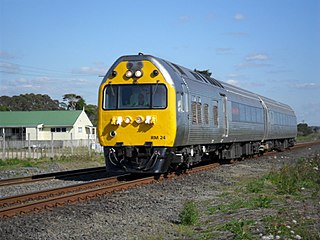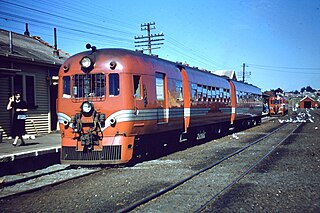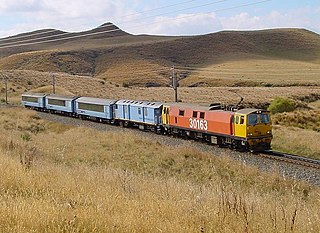
Rail transport in New Zealand is an integral part of New Zealand's transport network, with a nationwide network of 4,375.5 km (2,718.8 mi) of track linking most major cities in the North and South Islands, connected by inter-island rail and road ferries. Rail transport in New Zealand has a particular focus on bulk freight exports and imports, with 19 million net tonnes moved by rail annually, with 99.5% of New Zealand's exports and imports being transported through the country's seaports.

The North Island Main Trunk (NIMT) is the main railway line in the North Island of New Zealand, connecting the capital city Wellington with the country's largest city, Auckland. The line is 682 kilometres (424 mi) long, built to the New Zealand rail gauge of 1,067 mm and serves the large cities of Palmerston North and Hamilton.

The NZR RM class Silver Fern was a class of rail motor in New Zealand. The three air-conditioned and sound-proofed 723-kW 96-seater diesel-electric twin-set railcars were built by Kawasaki under contract with Nissho Iwai of Japan. New Zealand Railways (NZR) classified the railcars as RM , the same as other railcars, using the name "Silver Fern" after their stainless-steel construction, and echoed the name of the premier night train that also ran on the Wellington-Auckland route, the Silver Star.
The Southerner was a passenger express train in New Zealand's South Island between Christchurch and Invercargill along the South Island Main Trunk, that ran from 1970 to 2002. It was one of the premier passenger trains in New Zealand and its existence made Invercargill the southernmost passenger station in the world.
The New Zealand Railways Department, NZR or NZGR and often known as the "Railways", was a government department charged with owning and maintaining New Zealand's railway infrastructure and operating the railway system. The Department was created in 1880 and was corporatised on 1 April 1982 into the New Zealand Railways Corporation. Originally, railway construction and operation took place under the auspices of the former provincial governments and some private railways, before all of the provincial operations came under the central Public Works Department. The role of operating the rail network was subsequently separated from that of the network's construction. From 1895 to 1993 there was a responsible Minister, the Minister of Railways. He was often also the Minister of Public Works.

The NZR RM class 88-seaters were a class of railcar used in New Zealand. New Zealand Government Railways (NZR) classified them as RM , the notation used for all railcars, numbering the 35 sets from RM100 to RM134. They were the most numerous railcars in NZR service. Their purchase and introduction saw the demise of steam-hauled provincial passenger trains and mixed trains, and was part of a deliberate effort to modernise NZR passenger services at a time of increasing competition from private motor vehicles. Being diesel powered and lighter the railcars were less expensive to operate and able to maintain quicker timetables, although became plagued with mechanical and electrical problems, with a number of the class eventually being turned into depowered locomotive-hauled carriages and reclassified as the AC class "Grassgrubs".
The Endeavour was a long-distance passenger train service between Wellington and Napier in the North Island of New Zealand. The service was modelled on the Southerner service in the South Island, and operated from 1972 to 1989.
This is a list of jargon commonly used by railfans and railway employees in New Zealand.

The NZR KA class of 1939 was a class of mixed traffic 4-8-4 steam locomotives that operated on New Zealand's railway network. They were built after the success of the K class to meet the increasing traffic demands of the New Zealand Railways Department. The locomotives first appeared with distinctive streamlining, mainly to hide their ACFI feedwater heater systems.

The Overlander was a long-distance rail passenger train between Auckland and Wellington in the North Island of New Zealand, along the North Island Main Trunk (NIMT). It was operated by Tranz Scenic. The service was replaced from 25 June 2012, by the Northern Explorer.

The RM class was the classification used by the New Zealand Railways Department (NZR) and its successors gave to most railcars and railbuses that have operated on New Zealand's national rail network. "RM" stands for Rail Motor which was the common name at the turn of the 20th century for what became known in New Zealand as railcars. As many types of railcars are operated, class names have been given to each railcar type to differentiate them from others.
The Night Limited was an express passenger train that operated in New Zealand between Wellington and Auckland, utilising the entire length of the North Island Main Trunk. It commenced service on 15 December 1924 and was replaced by the Silver Star in 1971 and supplemented by the Northerner express in 1975.
The Daylight Limited was an express passenger train between Auckland and Wellington, New Zealand along the North Island Main Trunk. It commenced in 1925 and was replaced by the Scenic Daylight in 1963.

The NZR RM class Sentinel-Cammell was a steam-powered railcar operated by the New Zealand Railways Department (NZR). It was the only one of its type to operate in New Zealand, and one of only two steam railcars trialled in the country; the other was the Clayton steam railcar.
The New Plymouth Express was a passenger express train operated by the New Zealand Railways Department (NZR) between Wellington and New Plymouth. It ran from 1886 until 1955 and was sometimes known as the New Plymouth Mail due to the Railway Travelling Post Office carriages included in its consist. The Express was notable amongst NZR's provincial expresses as being both the first and, until the commencement of the Gisborne Express in 1942, the longest in distance travelled.
The Taranaki Flyer was the name given to a passenger train that was operated by the New Zealand Railways Department between Whanganui and New Plymouth from 1926 to 1965.
The New Plymouth Night Express was a passenger express train operated by the New Zealand Railways Department (NZR) that ran between Auckland and New Plymouth. It ran in various forms from 1933 until 1983, though the Express designation was lost in 1956 and later incarnations did not operate at night and terminated in Taumarunui rather than Auckland. The New Plymouth Night Express should not be confused with the New Plymouth Express that operated between New Plymouth and Wellington.
The Palmerston North–Gisborne Line (PNGL) is a secondary main line railway in the North Island of New Zealand. It branches from the North Island Main Trunk at Palmerston North and runs east through the Manawatū Gorge to Woodville, where it meets the Wairarapa Line, and then proceeds to Hastings and Napier in Hawke's Bay before following the coast north to Gisborne. Construction began in 1872, but the entire line was not completed until 1942. The line crosses the runway of Gisborne Airport, one of the world's only railways to do so since Pakistan's Khyber Pass Railway closed.
The Marton–New Plymouth line (MNPL) is a secondary main line railway in the North Island of New Zealand that links the Taranaki and Manawatū-Whanganui regions. It branches from the North Island Main Trunk railway (NIMT) at Marton and runs near the South Taranaki Bight of the west coast before turning inland, meeting the Stratford–Okahukura Line (SOL) at Stratford and running to New Plymouth. Construction of the line was completed in 1885, and along with the SOL it provided an alternate route to the NIMT from the SOL's completion in 1933 until the latter was mothballed in 2010. In its early days it was plied by the North Island's first regional express, the New Plymouth Express, but it has been freight only since the cancellation of the last passenger services in 1977.

The Northern Explorer is a long-distance passenger train operated by The Great Journeys of New Zealand division of KiwiRail between Auckland and Wellington in the North Island of New Zealand, along the North Island Main Trunk (NIMT). Three services operate per week in each direction between Auckland's The Strand Station and Wellington railway station. The Northern Explorer replaced the Overlander from 25 June 2012. It was suspended in December 2021, after suspension in August for the COVID lockdown, but is restarting on 25 September 2022.







